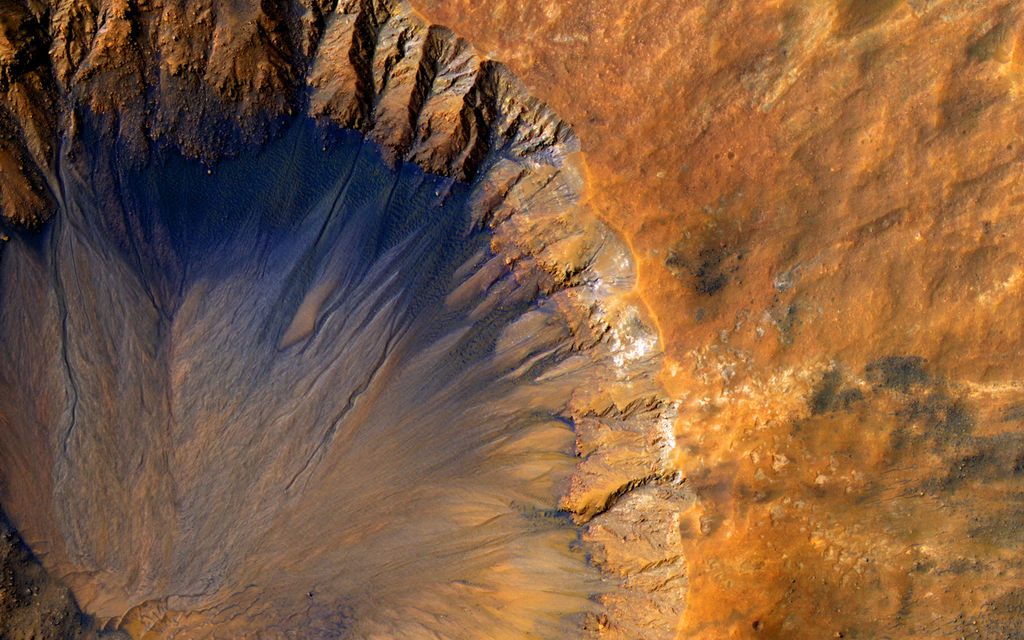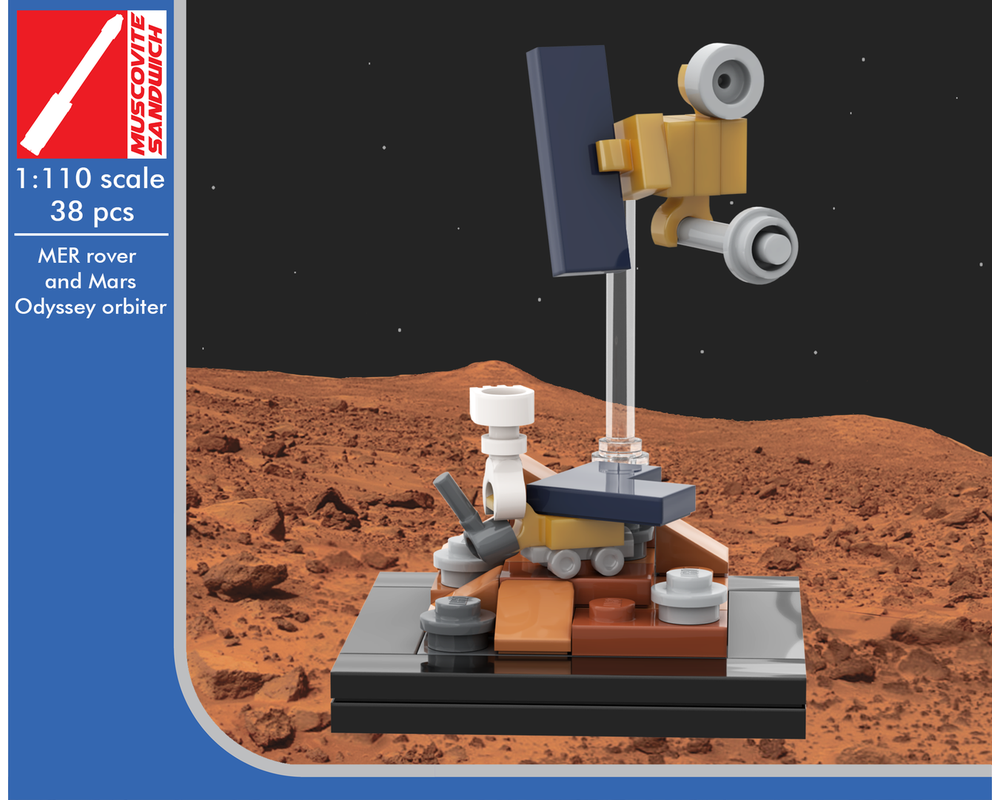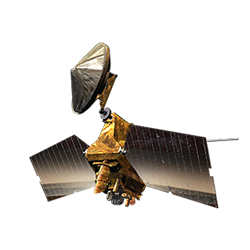Mars Odyssey
Mars Odyssey has been in space for 15 years, and has been returning science data from Mars since February of 2002. It flies in a special 'sun-synchronous' orbit. It crosses the equator at roughly the same local time every day. 2001 Mars Odyssey The cover image is an artist’s concept of 2001 Mars Odyssey in orbit around Mars communicating with the Deep Space Network via its large antenna and ready to communicate with vehicles on Mars’ surface beginning in 2004 via its ultra-high-frequency link.
- | News & Features
- | News Topics
- | Solar System
- Send
Feature
Text Size
Mars Odyssey From Two Distances in One Image

+ Larger image | + High resolution
Image above: NASA's Mars Odyssey spacecraft appears twice in the same frame in this image from the Mars Orbiter Camera aboard NASA's Mars Global Surveyor. The camera's successful imaging of Odyssey and of the European Space Agency's Mars Express in April 2005 produced the first pictures of any spacecraft orbiting Mars ever taken by another spacecraft orbiting Mars.
Mars Global Surveyor and Mars Odyssey are both in nearly circular, near-polar orbits. Odyssey is in an orbit slightly higher than that of Global Surveyor in order to preclude the possibility of a collision. However, the two spacecraft occasionally come as close together as 15 kilometers (9 miles).
The images were obtained by the Mars Global Surveyor operations teamsat Lockheed Martin Space System, Denver; JPL and Malin Space ScienceSystems.
The two views of Mars Odyssey in this image were acquired a little under 7.5 seconds apart as Odyssey receded from a close flyby of Mars Global Surveyor. The geometry of the flyby, seen at http://photojournal.jpl.nasa.gov/figures/PIA07941_fig1.jpg, and the camera's way of acquiring an image line-by-line resulted in the two views of Odyssey in the same frame. The first view (right) was taken when Odyssey was about 90 kilometers (56 miles) from Global Surveyor and moving more rapidly than Global Surveyor was rotating, as seen from Global Surveyor. A few seconds later, Odyssey was farther away -- about 135 kilometers (84 miles) -- and appeared to be moving more slowly. In this second view of Odyssey (left), the Mars Orbiter Camera's field-of-view overtook Odyssey.
The Mars Orbiter Camera can resolve features on the surface of Mars as small as a few meters or yards across from Mars Global Surveyor's orbital altitude of 350 to 405 kilometers (217 to 252 miles). From a distance of 100 kilometers (62 miles), the camera would be able to resolve features substantially smaller than 1 meter or yard across.
Mars Odyssey was launched on April 7, 2001, and reached Mars on Oct. 24, 2001. Mars Global Surveyor left Earth on Nov. 7, 1996, and arrived in Mars orbit on Sept. 12, 1997. Both orbiters are in an extended mission phase, both have relayed data from the Mars Exploration Rovers, and both are continuing to return exciting new results from Mars. JPL, a division of the California Institute of Technology, Pasadena, manages both missions for NASA's Science Mission Directorate, Washington, D.C.
Image Credit: NASA/JPL/MSSS
Mars Odyssey Seen by Mars Global Surveyor
Mars Odyssey 2002
 + Larger image | + High resolution
+ Larger image | + High resolutionImage left: This view is an enlargement of an image of NASA's Mars Odyssey spacecraft taken by the Mars Orbiter Camera aboard NASA's Mars Global Surveyor while the two spacecraft were about 90 kilometers (56 miles) apart. The camera's successful imaging of Odyssey and of the European Space Agency's Mars Express in April 2005 produced the first pictures of any spacecraft orbiting Mars ever taken by another spacecraft orbiting Mars.
Mars Global Surveyor and Mars Odyssey are both in nearly circular, near-polar orbits. Odyssey is in an orbit slightly higher than that of Global Surveyor in order to preclude the possibility of a collision. However, the two spacecraft occasionally come as close together as 15 kilometers (9 miles).
The images were obtained by the Mars Global Surveyor operations teams at Lockheed Martin Space System, Denver; JPL and Malin Space Science Systems.
The Mars Orbiter Camera can resolve features on the surface of Mars as small as a few meters or yards across from Mars Global Surveyor's orbital altitude of 350 to 405 kilometers (217 to 252 miles). From a distance of 100 kilometers (62 miles), the camera would be able to resolve features substantially smaller than 1 meter or yard across.

The components of Mars Odyssey when viewed from the same angle as this image can be seen in a computer drawing, http://photojournal.jpl.nasa.gov/figures/PIA07942_fig1.jpg, and an annotated computer drawing, http://photojournal.jpl.nasa.gov/figures/PIA07942_fig2.jpg, of Odyssey.
Mars Odyssey was launched on April 7, 2001, and reached Mars on Oct. 24, 2001. Mars Global Surveyor left Earth on Nov. 7, 1996, and arrived in Mars orbit on Sept. 12, 1997. Both orbiters are in an extended mission phase, both have relayed data from the Mars Exploration Rovers, and both are continuing to return exciting new results from Mars. JPL, a division of the California Institute of Technology, Pasadena, manages both missions for NASA's Science Mission Directorate, Washingon, D.C.
Image Credit: NASA/JPL/MSSS
Mars Express Seen by Mars Global Surveyor

+ High resolution
Mars Odyssey Facts
Image left: This picture of the European Space Agency's Mars Express spacecraft by the Mars Orbiter Camera on NASA's Mars Global Surveyor is from the first successful imaging of any spacecraft orbiting Mars by another spacecraft orbiting Mars. The picture is a composite of two views of Mars Express that Mars Orbiter Camera acquired on April 20, 2005, from distances of about 250 and 370 kilometers (155 and 229 miles).
Owing to the large distance between Mars Global Surveyor and Mars Express when the two views could be acquired and to a substantial cross-track component of apparent motion for which no correction could be made, Mars Express appears in the image as a narrow blur rather than as a well-defined spacecraft. It appears in the image to be about 1.5 meters in the small dimension and 15 meters in the long dimension, which is consistent with the viewing distance, pixel scale, and encounter geometry.
The components of Mars Express when viewed from the same angle as this image can be seen in an artist's rendition, http://photojournal.jpl.nasa.gov/figures/PIA07944_fig1.jpg, and an annotated rendition, http://photojournal.jpl.nasa.gov/figures/PIA07944_fig2.jpg, of the spacecraft.
Mars Express was launched on June 3, 2003, and reached Mars on Dec. 25, 2003. Mars Global Surveyor left Earth on Nov. 7, 1996, and arrived in Mars orbit on Sept. 12, 1997. JPL, a division of the California Institute of Technology, Pasadena, manages Mars Global Surveyor for NASA's Science Mission Directorate, Washingon, D.C.
Image Credit: NASA/JPL/MSSS.

Mission Overview
NASA’s Mars Odyssey orbiter arrived at Mars in 2001 to detect water and shallow buried ice on Mars and to study the planet’s radiation environment. Odyssey is part of the Mars Exploration Program’s long-term effort of robotic exploration of the red planet
Relevance to Astrobiology
Odyssey has provided global maps of chemical elements and minerals that make up the martian surface. Maps of hydrogen distribution led to the discovery of vast amounts of water ice buried just beneath the surface of Mars’ polar regions.
Mars Odyssey also acts as a relay for communications between other NASA missions at Mars relevant to astrobiology, including the rovers Opportunity and Curiosity.
NASA Astrobiology Involvement
Astrobiologists supported by the Astrobiology Program were directly involved in the development of the Thermal Emission Imaging System (THEMIS) instrument onboard Mars Odyssey. Visible and infrared observations by THEMIS are used to identify the distribution of minerals on Mars, allowing astrobiologists to study how the mineralogy of the planet relates to the landforms.
Astrobiologists also use data from Mars Odyssey to study the geochemical makeup of Mars. This information is useful for studying the evolution of Mars’ environment, identifying locations that may have been habitable for life in the past, and finding astrobiology-relevant landing sites for future Mars missions.
The Astrobiologists
NAI Arizona State University Team member Phil Christensen is the PI of the THEMIS instrument on this mission. Research by Christensen, Jack Farmer, Mikhail Zolotov and others into geochemical scenarios accounting for observed Mars mineralogy aids in interpreting data from this and other Mars missions.
